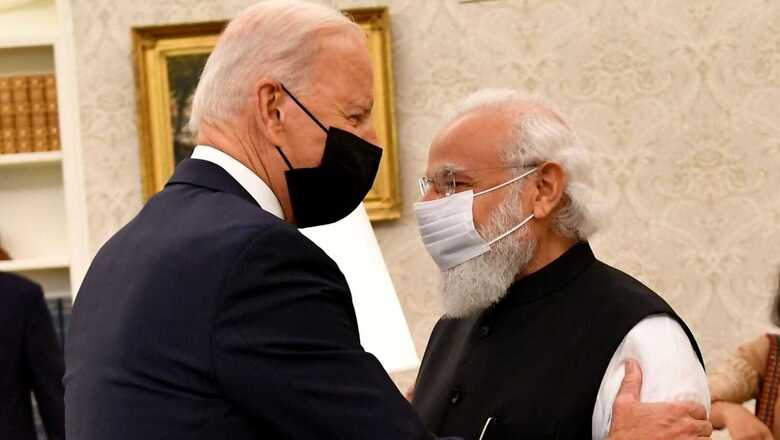
views
Prime Minister Narendra Modi’s visit to the United States was significant in many ways. It was his first visit to the US in the last two years and he was to meet President Biden the first time after he was elected as the President of the United States of America. With the exception of his Dhaka visit, this was his first major visit to a foreign country in two years.
The last two years were also a witness to several major changes across the globe. The world was hit by the COVID-19 pandemic and many countries are still reeling under its effect. In the US, there was a change of administration and Biden took over as the President. The recent events in Afghanistan where the Taliban have taken over the country have added a new dimension to the geopolitics of this region.
When Biden won the US presidential election, many observers commented that India would come under severe pressure from the US on several issues due to the enhanced influence of liberals on the administration. Contrary to these dire predictions, Biden has been in regular touch with Prime Minister Modi. In fact, they spoke three times before they met in-person on September 24.
ALSO READ | With Boost to Manufacturing and FDI, India is the Winner at Quad
In last two years, India has also faced challenges on several fronts. Chinese aggression in Ladakh region has again exposed the expansionist mindset of Beijing. At the same time India fought two severe waves of COVID-19, which put enormous stress on India’s healthcare system, economy, business and people’s lives in general.
Prime Minister Modi’s US visit, therefore, should be evaluated in this background. The signals from this visit are very encouraging. Both the leaders have displayed a strong chemistry and also a commitment to collaborate on common goals.
During the pandemic, India and the US have worked in collaboration on supply of essential medicines, preventive kits and later on supply of vaccines too. President Biden and Prime Minister Modi expressed deep pride and appreciation for their nations’ close cooperation to fight the COVID-19 pandemic in the last one year. Both the leaders have acknowledged that continued cooperation between the two countries is essential to vaccinate the entire world, a goal that is key to eliminating the pandemic. In order to achieve this goal, India has announced that it will soon restart export of vaccines to other countries and the US on its part has promised to supply 500 million doses of vaccines to countries in need.
The Taliban’s victory in Afghanistan poses a serious challenge not only to India and neighbouring countries but also the entire world—Afghanistan being a likely base for extremism, terrorism and supply of illicit drugs. India has already suffered a lot due to cross-border terrorism; therefore, it was but obvious that this issue would be a part of the discussion when both leaders meet.
It is noteworthy that Vice President Kamala Harris raised this issue impromptu during her meeting with Prime Minister Modi. PM Modi and President Biden have resolved to fight the challenge of terrorism together. They noted that the upcoming meetings between two countries on counter-terrorism will further strengthen cooperation, and welcomed opportunities to develop counterterrorism technologies.
Collaboration on the front-end technologies is also important in several other areas, such as artificial intelligence, robotics as well as in facing the climate change challenge. While both India and the US governments are working together in these areas, it is well-known that most of these technologies are being developed in the private sector. In this respect, Prime Minister Modi’s individual meetings with CEOs of five American companies that are involved in front-end digital technologies, solar energy and private investment were significant. After the meeting, each of these five companies have expressed their confidence in India’s intellectual capital, and expressed their desire to invest and collaborate with Indian companies.
ALSO READ | In Quad’s Semiconductor Gambit against China, India Stands to Gain
Another equally important meeting was the Quad summit. It was the first time Quad leaders were meeting in-person together and therefore there was enormous interest in this meeting. Although China was not mentioned in the joint Quad statement, several issues discussed during the meeting, such as cyber security infrastructure and creating alternate supply chain capabilities, have direct connection with the dominance of China in these sectors. In addition, Quad leaders have expressed their strong commitment to slow down the adverse effects of climate change. They have also announced working groups to collaborate on developing standards for advanced technologies. Their unambiguous statement on Afghanistan is also welcome news. The leaders have also emphasized people-to-people collaboration. US President Biden announced 25 scholarships each for students from Quad countries to pursue higher studies in STEM.
The first in-person meeting of the world leaders of Quad has given a lot of clarity on the aims and objectives of Quad. Even Quad member countries had some hesitation to directly identify themselves with the group. It is noteworthy that even India has avoided using the word ‘Quad’ till recently. These hesitations have now been permanently overcome. On the other hand, adversaries of Quad compare it with Nato.
The September 24 declaration after the Quad meeting has unambiguously stated that it is not a security alliance like NATO but has a much wider agenda. Collective determination of four democratic forces is likely to address diverse issues affecting mankind and try to present a collaborative approach to solutions and policies for the entire world.
The author is in-charge, Foreign Affairs Department, Bharatiya Janata Party. The views expressed in this article are those of the author and do not represent the stand of this publication.
Read all the Latest News , Breaking News and Ukraine-Russia War Live Updates here.


















Comments
0 comment